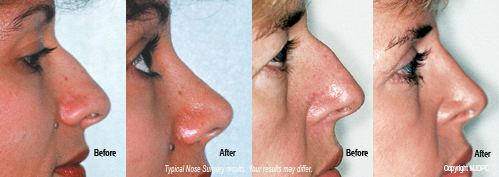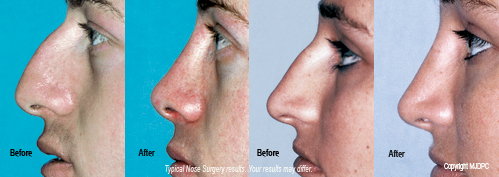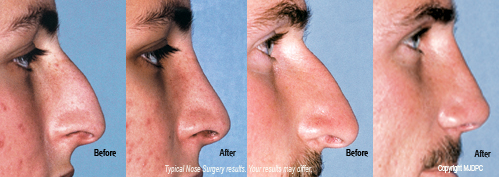Your nose is the most prominent feature on your face, second only to your eyes. Its size and shape may be the most defining characteristic of your face. If you are unhappy with your nose, you're not alone.
Every year, hundreds of thousands of people throughout the United States elect to improve the appearance and/or function of their noses through nose surgery or rhinoplasty. Some people want a different size or shape. Others wish to repair damage caused by an injury, and some just want to breathe easier. Nose surgery is performed by our doctor for patients in our region to improve your self-confidence or your breathing.

Your nose surgery consultation
The ideal nose varies from face to face depending on skin type, ethnic background, age, and other variables. During your initial cosmetic consultation, our physician will discuss your concerns about your nose, your expectations, and explain the probable outcome of your procedure.
We may show you several before and after treatment photographs of patients having similar noses, and we will explain the treatment you can expect to receive. Before and after photos may be taken of your nose to document your results.

Other considerations with nose surgery
Before making the decision to have a rhinoplasty, ask our surgeon if there are any additional facial procedures that may enhance the effects of your nose surgery. Many patients elect to have chin or cheek implants to enhance and balance their facial features.
The nose surgery procedure
Rhinoplasty is the reshaping of the nose. It can be performed on an outpatient basis under local or general anesthesia. The procedure usually takes 1 - 2 hours, although a complicated procedure may take longer. Most incisions are made inside the nose, where they are invisible. The skin and tissues of the nose along with the underlying bone and cartilage are sculpted by the surgeon to your desired new shape.
If your nose is too large, for example, your surgeon may sculpt away cartilage to reduce its size. Noses that point up or droop down can be redirected by trimming the septum which divides the two nasal passages. Skin can be removed from both sides of the nostrils at the center, to narrow the base of the nose. Sometimes the contour can be improved by adding tissue.

What about insurance for nose surgery?
Breathing problems are common, even in younger people. Correcting problems that interfere with your breathing may be covered by your health insurance. However, when a rhinoplasty is performed for cosmetic reasons, it may not be covered, in part or in whole, by your health insurance. It is the patient's responsibility to check with their insurance provider for information on the degree of coverage. We will be happy to answer any questions you have regarding payment.
What will my recovery from nose surgery be like?
After our doctor performs rhinoplasty, patients are up and active within 2 days. Your first day should be spent in bed with your head elevated. You will wear a small splint over your nose to protect it and keep it stable, for a week or so. Your nose and head will probably ache and your face will feel puffy. This discomfort can be alleviated with medication prescribed by your surgeon. After about 3 days, the swelling and bruising around your eyes will begin to subside. It should be almost completely gone in about 2 weeks. Cold compresses applied to the area will help reduce the swelling.
Some bleeding is common the first few days after surgery, along with some stuffiness that could last a few weeks. It is recommended that you not blow your nose during the first week while the tissues are healing. After 10 - 12 days all dressings, splints, and sutures should be removed and you can return to a normal life. Strenuous activities, rubbing or bumping your nose should be avoided for several more weeks.